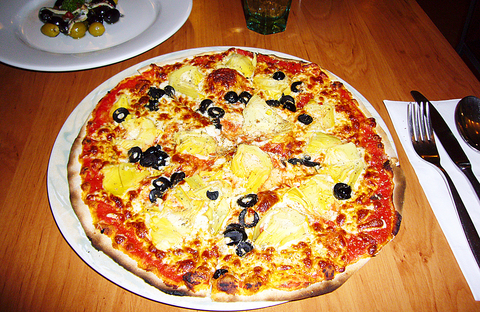The first thing one notices upon entering Cosi o' Cosi are the fresh smells of tomato sauce, baked bread and spices. As there the restaurant's first floor is a no smoking area — there are tables out the front and on the second floor — there is no odor to impede succulent scents wafting out from the ovens. Complimenting the warm smells are friendly service and atmosphere. It is the kind of place to bring a first date, the food solid but not outrageously priced if there is no second in the offing.
Standing at the bar are a number of servers unobtrusively waiting to pick up orders and bring out dishes. They are all decked out with headsets and the observant customer can see them constantly dictating orders to the open kitchen in the back. The bar itself is a colorful array of chipped tiles with a white background.
The menu is limited but well constructed. Where it does excel is on the appetizers. The Olive e Acciughe Fresche (NT$180) is a mouth-watering teaser with mixed olives holding up fresh anchovies. The latter are not salty or fishy and go perfectly with a slice of freshly baked crostini (NT160). No visit to an Italian restaurant would be complete without an order of caprese (NT$380). Though a little pricey, the mozzarella is fresh.

PHOTO: NOAH BUCHAN, TAIPEI TIMES
For the carnivorous, the sliced beef tenderloin with Parmesan in lemon sauce (NT$380) will curl your whiskers with delight.
The pizza menu tends toward the simple and exotic but the selection is wide-ranging and the portions filling. Ranging in price from NT$280 to NT$440, all pizzas are made from scratch and are placed into the oven only when the server speaks into their headset. The highly recommended carciofi (NT$320) is a combination of artichoke, olives, chili, garlic, and mozzarella. The adventurous will love the salami, Gorgonzola, spinach and mozzarella diavola e Gorgonzola spinici (NT$420). For the genuine cheese lover and risk-taker, the quattro formaggi (NT$440) — a four-cheese zinger that includes Gorgonzola, Brie, ricotta and mozzarella — will make the clogged arteries worthwhile.
The pasta menu is even more limited than the pizza menu, but that should not dissuade you, for what that small section lacks in quantity is made up for in quality. The linguine al vongle (NT$320) is a simple linguine and clams done up right with white wine. For those who like more of a taste explosion in their feasting, the linguine with shrimp in spicy tomato sauce linguine all'arrabbiata con gamberetti (NT$380) is a good bet.

May 11 to May 18 The original Taichung Railway Station was long thought to have been completely razed. Opening on May 15, 1905, the one-story wooden structure soon outgrew its purpose and was replaced in 1917 by a grandiose, Western-style station. During construction on the third-generation station in 2017, workers discovered the service pit for the original station’s locomotive depot. A year later, a small wooden building on site was determined by historians to be the first stationmaster’s office, built around 1908. With these findings, the Taichung Railway Station Cultural Park now boasts that it has

The latest Formosa poll released at the end of last month shows confidence in President William Lai (賴清德) plunged 8.1 percent, while satisfaction with the Lai administration fared worse with a drop of 8.5 percent. Those lacking confidence in Lai jumped by 6 percent and dissatisfaction in his administration spiked up 6.7 percent. Confidence in Lai is still strong at 48.6 percent, compared to 43 percent lacking confidence — but this is his worst result overall since he took office. For the first time, dissatisfaction with his administration surpassed satisfaction, 47.3 to 47.1 percent. Though statistically a tie, for most

Wooden houses wedged between concrete, crumbling brick facades with roofs gaping to the sky, and tiled art deco buildings down narrow alleyways: Taichung Central District’s (中區) aging architecture reveals both the allure and reality of the old downtown. From Indigenous settlement to capital under Qing Dynasty rule through to Japanese colonization, Taichung’s Central District holds a long and layered history. The bygone beauty of its streets once earned it the nickname “Little Kyoto.” Since the late eighties, however, the shifting of economic and government centers westward signaled a gradual decline in the area’s evolving fortunes. With the regeneration of the once

In February of this year the Taipei Times reported on the visit of Lienchiang County Commissioner Wang Chung-ming (王忠銘) of the Chinese Nationalist Party (KMT) and a delegation to a lantern festival in Fuzhou’s Mawei District in Fujian Province. “Today, Mawei and Matsu jointly marked the lantern festival,” Wang was quoted as saying, adding that both sides “being of one people,” is a cause for joy. Wang was passing around a common claim of officials of the People’s Republic of China (PRC) and the PRC’s allies and supporters in Taiwan — KMT and the Taiwan People’s Party — and elsewhere: Taiwan and